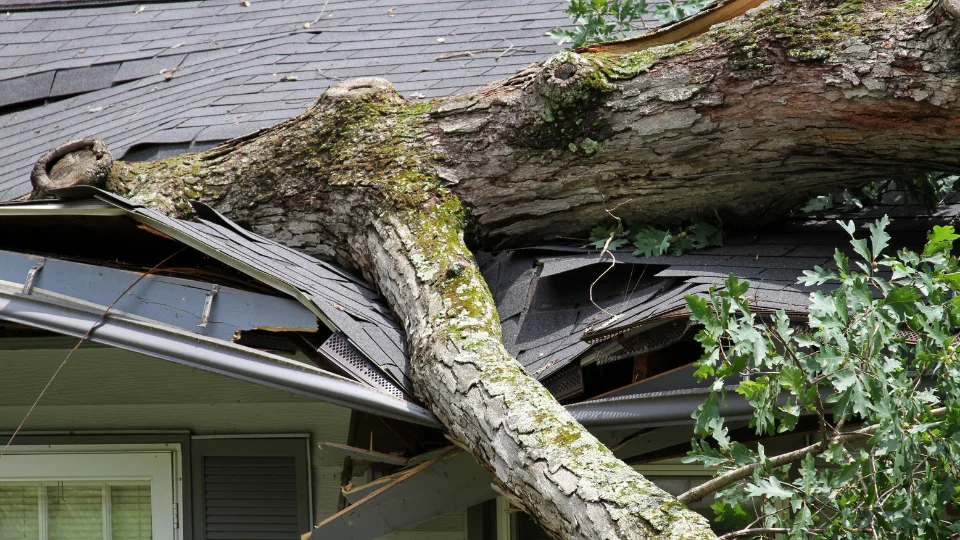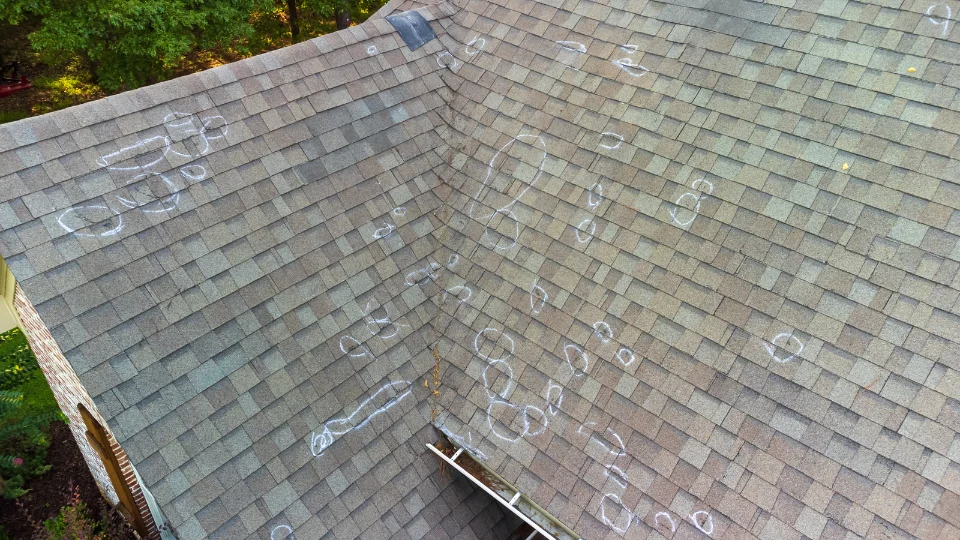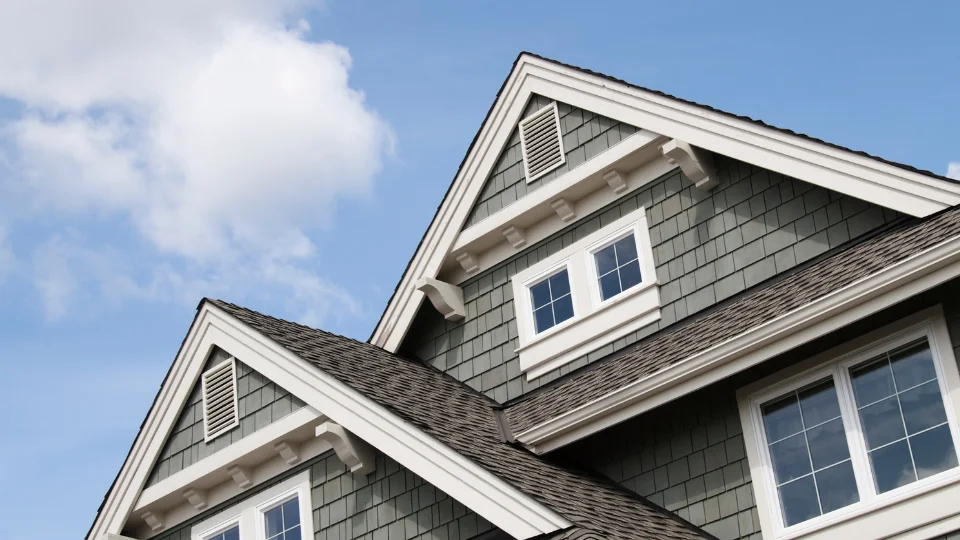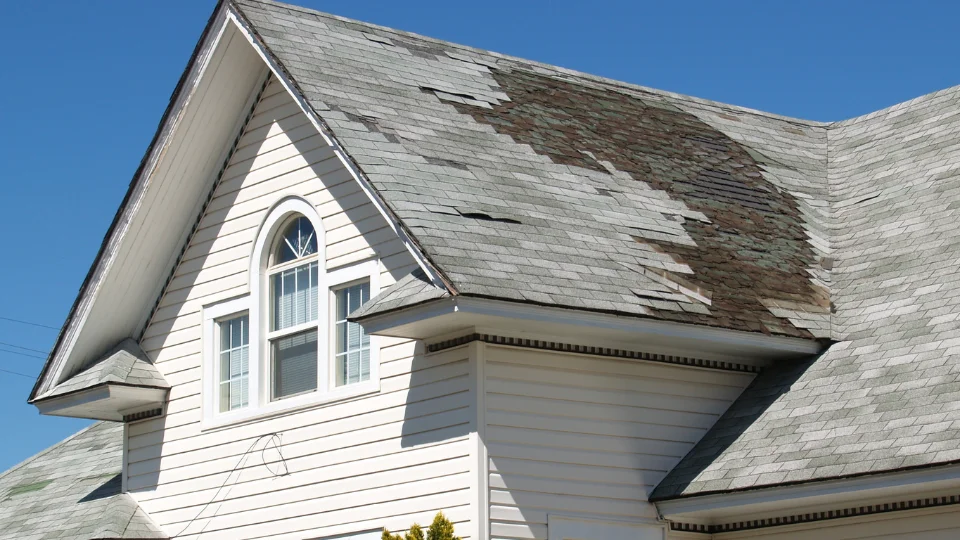Dealing with roof damage can be frustrating for homeowners. A common issue they face is distinguishing between Roof Blistering Vs Hail Damage. Our article breaks down the differences and how to identify each problem effectively.
Understanding the Difference: Roof Blistering Vs Hail Damage
Roof blistering vs hail damage: the difference is crucial for homeowners. Identifying the types of roof damage, understanding differences in appearance and causes, and recognizing the importance of knowing the difference are essential steps.
Identifying the types of roof damage
Roof damage affects the protection and appearance of your home. Hail damage often leaves distinct dents and marks on shingles, resembling dimples you might find on a golf ball. These impressions signal that the roof has faced the brunt of a hailstorm.
On the other hand, blistering appears as raised areas or bubbles on shingle surfaces. This condition results from moisture trapped in shingles expanding from heat exposure.
Understanding these signs is crucial for early detection and repair.
Differences in appearance and causes
Roof blistering and hail damage often confuse homeowners due to their impact on shingles. Blistered shingles display raised areas that look like bubbles, primarily caused by moisture trapped within the shingle layers or poor ventilation in the attic.
Heat from the sun exacerbates these blisters, causing them to expand and eventually pop. This leaves behind cracks where water can seep through, leading to potential leaks.
On the other hand, hail damage presents a different story. Hailstones strike with force, leaving dents or pockmarks on shingles. These impacts are not uniform; they vary in size based on the hailstone’s size, making visual identification somewhat easier than blistering.
The cause here is purely weather-related – as hailstorms hit suddenly without much warning, causing immediate damage to roofing materials unlike the gradual deterioration seen with blistering.
Importance of knowing the difference
Understanding the difference between roof blistering and hail damage is crucial for effective property maintenance. Identifying whether your roof has suffered from weather-related damage due to a hailstorm or if it’s showing signs of blistered shingles can influence the approach you take in repairs.
Accurate diagnosis ensures that roofing issues are corrected with appropriate solutions, preventing further damage.
Knowledgeable homeowners save on costly repairs by addressing roofing problems early on. Spotting the specific type of shingle damage helps in making informed decisions regarding roof maintenance, weatherproofing, and when necessary, complete roof repair.
It also plays a significant role in discussions with insurance companies about coverage for exterior damage caused by severe weather patterns. Proper identification avoids unnecessary expenses and extends the lifespan of roofing materials.
How to Spot Roof Blistering and Hail Damage

Spotting roof blistering vs hail damage is essential for maintaining the integrity of your home. Seek visual indicators such as patterned dents or punctures on shingles when assessing potential hail damage. Moreover, examine for raised, bubble-like formations on asphalt shingles to identify signs of roof blistering.
Visual appearance and distribution patterns
The visual appearance of roof blistering includes raised, bubble-like formations on the surface of shingles. These blisters are irregular in shape and can vary in size, generally 1 to 2 inches in diameter.
They often appear scattered across the roof rather than being concentrated in one area. In contrast, hail damage is characterized by dents or bruises on the surface of the shingles, resembling circular marks that are distributed randomly across the roof.
Roof blistering presents as raised bubble-like formations on shingle surfaces; whereas hail damage results in random circular marks resembling dents or bruises across the roofing.
Additional clues to look for
Inspecting the condition of flashing around roof penetrations, such as vents and chimneys, can provide further insight. Discoloration or rust on the flashing may indicate water damage.
Moreover, checking for granule loss in gutters and downspouts could signal hail damage to shingles. It’s crucial to examine these areas thoroughly when evaluating potential roof damage after a weather event.
Examining nearby outdoor features like air conditioning units and vehicles for signs of similar damage can help support suspicions of hail-related roof issues. If evidence suggests widespread harm in surrounding structures or objects, it strengthens the rationale for contacting a professional roofer to assess your own property.
These additional indicators are valuable in distinguishing between blistering and hail-related damage and play a vital role in comprehending the extent of potential issues with roofing materials.
Response to external factors
When responding to external factors such as severe weather, it is essential to promptly address any visible roofing damage. Acting quickly can prevent further deterioration and more extensive repairs in the future.
Conducting comprehensive inspections after a hailstorm or extreme weather event is crucial in identifying roof blistering and hail damage, allowing for specific repairs that align with your insurance needs.
Furthermore, collaborating closely with reputable roofing professionals who understand the nuances of weather-related damage can ensure effective and lasting solutions for maintaining the integrity of your home’s roof.
Dealing with Damaged Roofs
Dealing with damaged roofs involves targeted repairs, understanding the economic implications and taking preventative measures to maintain your property. Learn more about handling roof damage in our full article.
Importance of targeted repairs
Targeted repairs are crucial in addressing specific damages to your roof. Fixing only the affected areas can save you money and time by avoiding unnecessary work on undamaged sections.
This ensures that resources are used efficiently, minimizing costs for both materials and labor. Identifying the exact issues allows for a more focused approach to restoration, maintaining the integrity of your roofing system while attending to weather-related damage from hailstorms with targeted repairs.
Targeted repairs also play a key role in maintaining property value and preventing further deterioration of the roof’s structure. By promptly addressing damaged areas, homeowners can avoid substantial economic implications caused by long-term neglect.
These repairs contribute to extending the lifespan of a roof and ensuring its continued protection against future weather events such as hailstorms or blistering.
Economic implications
Repairing roof blistering and hail damage can have significant economic implications for homeowners. Promptly addressing these issues can prevent further deterioration, saving on costly repairs down the line.
Failing to address these problems could have a substantial financial burden and impact home insurance premiums due to increased risk of structural issues.
Additionally, neglecting these damages might affect the property’s overall value when it comes time to sell or refinance. Potential buyers may negotiate lower prices if they discover unaddressed roof problems during inspections.
Stay proactive by addressing any roofing concerns promptly; this will not only preserve your investment but also contribute to maintaining the long-term value of your home.
Moving forward with targeted repairs is crucial in mitigating potential economic repercussions caused by neglected roof damage and ensuring continued structural integrity and property value.
Preventative measures
To prevent costly repairs and maintain the integrity of your roof, consider these preventative measures:
- Regular Inspections: Schedule annual professional roof inspections to identify potential issues early.
- Maintain Gutters: Keep gutters and downspouts clear of debris to prevent water buildup and damage.
- Trim Overhanging Branches: Prevent damage from falling branches by keeping trees near your home well-maintained.
- Install Impact-Resistant Shingles: Consider upgrading to impact-resistant shingles to better withstand hail damage.
- Weatherproofing: Apply weatherproof coatings or sealants to enhance your roof’s durability against extreme weather conditions.
By implementing these preventative measures, you can protect your roof from extensive damage and prolong its lifespan, saving on maintenance costs in the long run.
Landmark Roofing: Your Partner in Roof Repairs
Knowing the difference between roof blistering and hail damage is key to keeping your roof in top shape. With this knowledge, you can take quick action to prevent further issues. Specific repairs and preventative steps are essential for long-term roof stability.
At Landmark Roofing, we’re here to help you manage any weather-related damage with effective solutions. Contact us today to ensure your roof is well-maintained and protected. Let us help you safeguard your home with expert care and service.
FAQs
1. What are the signs of roof blistering caused by weather?
Signs of roof blistering due to weather include raised areas on the roof, visible bubbles, and a spongy feel when touched.
2. How can I distinguish hail damage from roof blistering?
Hail damage typically appears as dents or dimples in roofing materials, while roof blistering manifests as raised areas with visible bubbles.
3. Can a professional inspection help differentiate between hail damage and roof blistering?
Yes, a professional inspection can accurately identify whether your roofing issues are caused by hail damage or roof blistering.
4. Is it important to address these issues promptly?
Yes, addressing these issues promptly is crucial to prevent further damage and maintain the integrity of your home’s structure.






